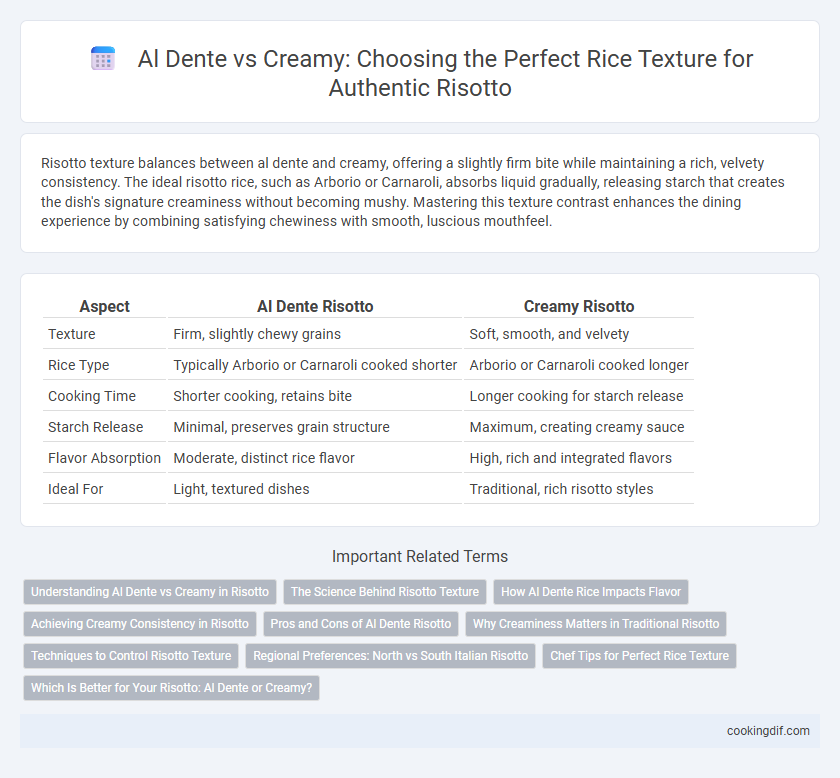Risotto texture balances between al dente and creamy, offering a slightly firm bite while maintaining a rich, velvety consistency. The ideal risotto rice, such as Arborio or Carnaroli, absorbs liquid gradually, releasing starch that creates the dish's signature creaminess without becoming mushy. Mastering this texture contrast enhances the dining experience by combining satisfying chewiness with smooth, luscious mouthfeel.
Table of Comparison
| Aspect | Al Dente Risotto | Creamy Risotto |
|---|---|---|
| Texture | Firm, slightly chewy grains | Soft, smooth, and velvety |
| Rice Type | Typically Arborio or Carnaroli cooked shorter | Arborio or Carnaroli cooked longer |
| Cooking Time | Shorter cooking, retains bite | Longer cooking for starch release |
| Starch Release | Minimal, preserves grain structure | Maximum, creating creamy sauce |
| Flavor Absorption | Moderate, distinct rice flavor | High, rich and integrated flavors |
| Ideal For | Light, textured dishes | Traditional, rich risotto styles |
Understanding Al Dente vs Creamy in Risotto
Al dente risotto features rice grains cooked to maintain a firm, slightly chewy center, highlighting individual grain texture and a more defined bite. Creamy risotto, often achieved by slow cooking and stirring, results in a soft, smooth texture where starches are fully released, creating a rich, velvety consistency. Understanding this balance is crucial for mastering risotto, as the ideal dish combines tender rice with just enough firmness to prevent it from becoming mushy.
The Science Behind Risotto Texture
Risotto's texture balance stems from the starch composition of short-grain rice varieties like Arborio or Carnaroli, which release amylopectin during slow cooking, creating a creamy consistency. Achieving an al dente center requires precise timing to allow the rice grains to soften while maintaining a firm core, preserving optimal bite. The creamy outer layer results from continuous stirring and gradual addition of broth, which enhances the starch release and emulsifies the cooking liquid for a rich, velvety finish.
How Al Dente Rice Impacts Flavor
Al dente rice in risotto provides a firm texture that enhances the overall mouthfeel and prevents the dish from becoming overly soft or mushy. This slight resistance in each grain allows the natural starches to release gradually, resulting in a more balanced and nuanced flavor profile. Maintaining al dente rice preserves the integrity of the grains, intensifying the aromatic qualities of ingredients like Parmesan, saffron, and herbs.
Achieving Creamy Consistency in Risotto
Achieving a creamy consistency in risotto requires using short-grain rice varieties like Arborio, Carnaroli, or Vialone Nano, which release starch during slow cooking. Constant stirring and gradual addition of warm broth encourages the rice to break down slightly, creating the signature velvety texture without losing an al dente bite. Mastering the balance between creamy and firm grains results in the ideal risotto texture prized in Italian cuisine.
Pros and Cons of Al Dente Risotto
Al dente risotto offers a firmer, more textured bite that highlights the individual grains of Arborio or Carnaroli rice, preserving nutritional integrity by avoiding overcooking. This texture can enhance meal presentation and provide a satisfying contrast to succulent ingredients like mushrooms or seafood, though it may lack the traditional creamy consistency that many expect from risotto. However, al dente grains can sometimes result in a less cohesive dish, making it challenging to achieve the signature rich mouthfeel synonymous with classic Italian risotto recipes.
Why Creaminess Matters in Traditional Risotto
Creaminess defines the authentic texture of traditional risotto by ensuring the rice grains release starch, creating a rich, velvety consistency that complements the dish's flavor profile. Al dente rice offers firmness but lacks the luscious mouthfeel essential for balancing the savory broth and ingredients. Achieving the perfect creamy texture requires slow cooking and constant stirring to meld the starches, highlighting risotto's unique culinary identity.
Techniques to Control Risotto Texture
Controlling risotto texture hinges on precise cooking techniques that balance al dente firmness with creamy consistency. Gradual addition of hot broth allows the rice to release starch evenly, creating a velvety texture while maintaining some bite. Stirring constantly prevents rice from sticking and promotes uniform cooking, ensuring the ideal interplay between creamy and al dente textures in perfectly made risotto.
Regional Preferences: North vs South Italian Risotto
Northern Italy favors risotto with a creamy texture achieved by slow cooking and constant stirring, emphasizing a rich, velvety finish, while maintaining the rice slightly tender but not mushy. Southern Italian risotto often leans toward an al dente texture, where the rice grains remain firmer and more distinct, reflecting the regional preference for a more structured bite. This contrast highlights the regional culinary identities, with the North aligning with luxury and indulgence and the South preserving traditional, robust textures.
Chef Tips for Perfect Rice Texture
Achieving the perfect risotto texture involves balancing al dente firmness with creamy consistency for optimal mouthfeel. Chefs recommend using Arborio or Carnaroli rice, which release starch gradually to create creaminess while maintaining a slight bite at the center. Stirring continuously and adding warm broth incrementally allows precise control over the rice's texture, ensuring it remains tender yet resilient.
Which Is Better for Your Risotto: Al Dente or Creamy?
Creamy risotto is traditionally favored for its rich, velvety texture achieved by slow cooking Arborio rice, which releases starch and creates a luscious consistency. Al dente rice offers a firmer bite and distinct grains, appealing to those who prefer texture contrast and less starchiness in their dish. Optimal risotto balances creaminess with a slight al dente firmness, enhancing both flavor absorption and mouthfeel.
Al dente vs creamy for rice texture Infographic

 cookingdif.com
cookingdif.com